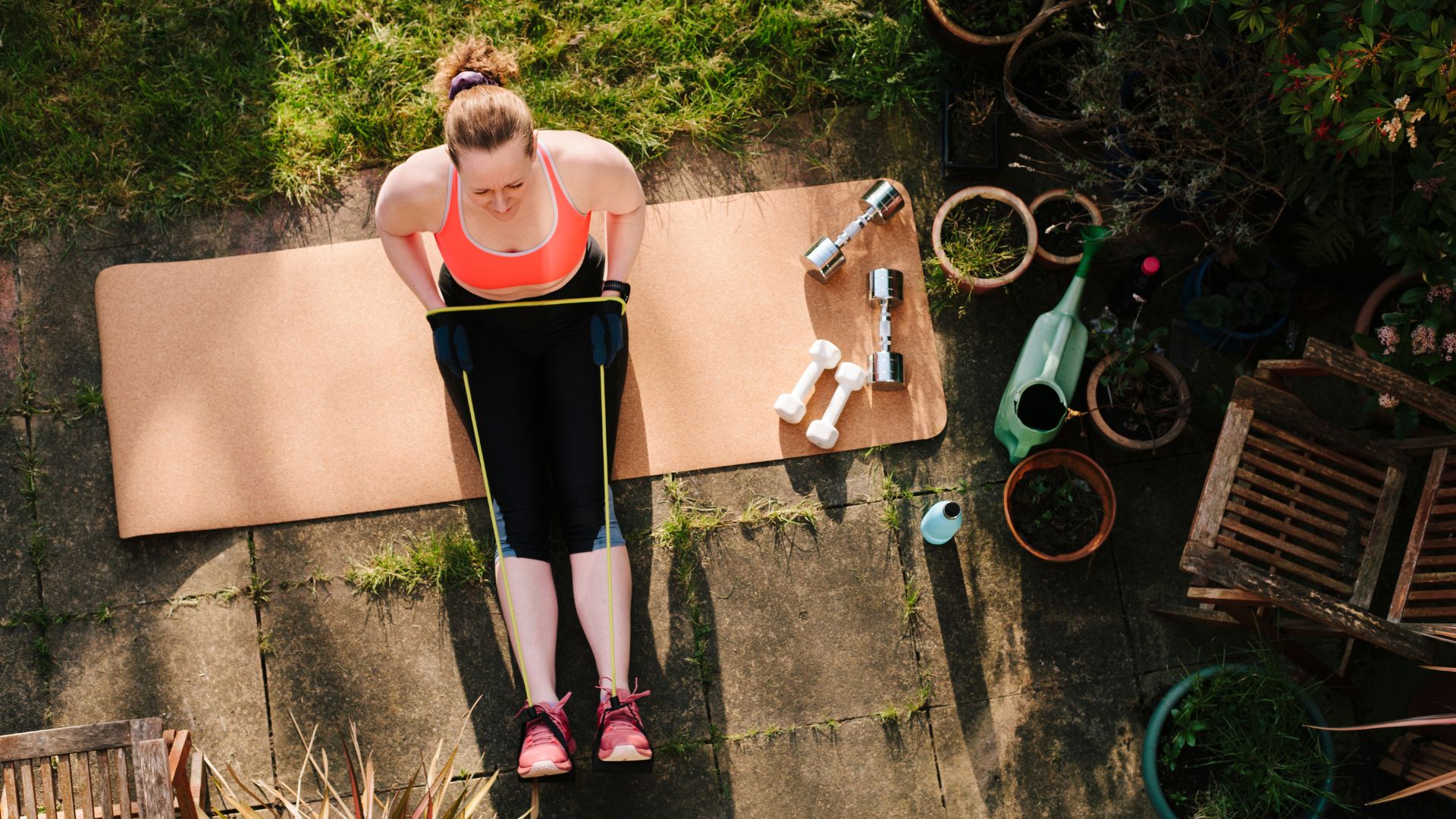How to start running for weight loss, according to the experts
Running for weight loss is a great exercise for beginners, provided you can do it safely


Kate Carter
A program of running for weight loss is one of the most common ways people try to lose weight. It's almost completely free to do, doesn't require much equipment, and it's suitable for everyone at almost every level of fitness. Plus, there's a whole host of benefits available aside from losing weight, like a boost to your cardiovascular and bone health.
It's hardly an easy activity though, with some novice runners taking to the pavement and losing pounds quickly while others don't see changes until they establish a regular routine, and some people don't see the benefits ever. It all depends on how you're running for weight loss and whether you manage to maintain a calorie deficit.
To explain exactly how and why it works, all the benefits of running for women, plus all the tips you need to get started, here woman&home has consulted a host of personal trainers, nutrition coaches, doctors, and movement experts. All you need to do is lace up your pick of the best running shoes and get going.
How to start running for weight loss
1. Start slow
Running is by no means an easy sport don't expect to start running 30 minutes a day from day one. It's tough on your joints, muscles, cardiovascular, and respiratory system, so start out slow if you're learning how to start running for the first time. "I'd suggest your first few sessions ought to be brisk walks of around 30 minutes maximum," says David Wiener, a personal trainer and specialist health coach, pointing to the many benefits of power walking for those new to running.
"Rather than running straight away, allow for a minimum of six weeks to build up a regular schedule of exercise. Toward the end, alternate between walking and jogging, and aim to increase your jogging time each session," says Wiener, who works with workout and wellbeing platform Freeletics.
And even then, be prepared for your muscles to ache, warns Anaya Grover, a functional training and movement specialist. "If you have little to no experience of running, you'll be able to make progress very quickly, which is great. But you also need to accept that you will be out of breath, your heart rate will increase, and you will feel the burn and muscular ache that comes afterward. These are normal physiological processes that occur when you exercise."
2. Combine exercise with changes to your diet
Running can be a great weight loss tool, but as Wiener explains, it shouldn't be the only one you use. Weight loss all depends on a calorie deficit and while it's entirely possible to lose weight without dieting strictly, you'll need to be burning more calories than you eat every day to see any changes. While some people choose to do this exclusively with exercise, it's a much harder process than changing what you eat and how you move at the same time.
Sign up for the woman&home newsletter
Sign up to our free daily email for the latest royal and entertainment news, interesting opinion, expert advice on styling and beauty trends, and no-nonsense guides to the health and wellness questions you want answered.
The University of Aarhus supports this idea. The research found the combined effort of running with a diet change was the most effective way to incorporate running into a weight loss regime. They looked at a selection of novice runners and found that those who combined healthy eating with exercise lost 3.8kg more on average than those who just ran 3.11 miles (5km) every week.
It's also important to consider what you're eating if you're looking to lose weight as, according to research by Loughborough University and as any runner will tell you, working out in such an intense way tends to spike the hunger hormones. This means you're more likely to eat more post-exercise than you otherwise would, potentially pushing yourself out of any potential deficit. While it won't be suitable for everyone, one of the best calorie counter apps like Lifesum or MyFitnessPal, can be hugely beneficial in helping you keep track of how many calories you're eating every day.
Plus, Wiener adds, "smartwatches and fitness trackers are great for tracking out distance and pace when we're running but the calorie burn count is often much higher on them than in reality. If you eat based on what your watch is saying you've burned, you're unlikely to make significant progress quickly."
3. Get motivated
Losing weight healthily and sustainably is all about staying consistent, which is why it's important to enjoy running in the first place, says personal trainer Mollie Millington. "If you hate it or have had negative experiences, you'll be reluctant to get out the door," she warns. "Meet a friend or join a run club, to both schedule the run into your day and hold you accountable."
But just because you enjoy running (or the idea of it), it doesn't mean you'll stay motivated 24/7. It's more than likely you'll have to find that motivation elsewhere at points, says Dr Abby Hyams, a general practitioner. She suggests workout apps to both help create training plans and keep motivation high as you'll be tracking your runs and progress over the weeks. Many of the best running apps also have AI or real-life coaches to offer tips and training advice, general words of motivation, and answer any questions you might have.
"Couch to 5k is one of my favorites for beginners," she tells us. "Strava allows you to track your pace, time, and distance, which is also great motivation as you aim you beat your own personal records and share your results with friends if you want to."

4. Invest in good running gear
The best running gear for you doesn't have to be the most expensive or high-tech, says Millington, but it's essential to have the basics so you can move easily and comfortably, and keep moving consistently.
"Make sure you have some decent trainers, one of the best sports bras, leggings, and a t-shirt," she suggests. "Somewhere safe to keep your phone and house keys is also a good idea, like a running vest, and if you're planning to work out at night, a light so cars can spot you. In the colder months, be sure to layer up so you don't freeze."
5. Prioritize recovery
Recovery is just as important as exercise when it comes to making progress, the experts agree. "Allow at least two complete rest days per week to avoid overtraining, which may cause injury and prevent you from running as much as you want to," says Wiener.
After each session, be sure to stretch out. "Always stretch before running or conducting any exercise," says Farren Morgan, a personal trainer and tactical athlete. "Static exercises will loosen your muscles and prepare your joints for the workout to come, while dynamic exercises will increase your heart rate and blood circulation so that your body's fully prepared."
Sleep is another essential element of this recovery process - and one that shouldn't be undervalued. "If you think six hours sleep is enough, think again," says Morgan. "That's the minimum amount of sleep new runners should be having each night, preferably it's seven to eight hours. This gives the body the time it needs to rest and recover from strenuous exercise."
6. Gradually increase your distance and speed
Once you're comfortable with running, the experts suggest graduating slowly to a longer distance and/or faster speed. While you may want to keep your metrics the way they are, and that's totally fine provided you're enjoying it, it'll come as no surprise that doing more burns more calories.
"Running at a decent pace burns more calories than most other types of exercise because it requires many different muscles to work together," says Wiener. "In addition, you may continue to burn calories long after the workout thanks to afterburn, or excess oxygen consumption [EPOC], which is caused by an elevated metabolism post-exercise."

7. Add in some strength training
"A mix of HIIT and strength training is a great addition to running," says Wiener, and it's pretty integral if you're looking to lose weight sustainably as "the more lean muscle mass you have, the more calories you'll burn not doing any exercise."
Contrary to popular belief, we actually burn most of our calories doing not much at all - activities like sleeping, sitting down and even eating. This is known as the basal metabolic rate (BMR) and it's the calories our body burns fulfilling these vital processes throughout the day. The more muscle mass we have, the faster our BMR is, meaning we burn more calories completing these processes, so it's easier to stay in the deficit.
Strength training, or weightlifting, can also help keep us moving consistently - the all-important key when it comes to running for weight loss."It will build up your leg muscles, which will in turn help you deliver more power and strengthen connective tissues, making you less prone to injury. Improving your upper-body strength can also boost your running efficiency. With a stronger core, you'll be able to maintain a stable upper body and minimize side-to-side movement," says Wiener.
But this doesn't have to mean huge weights and a compulsory gym membership, says Meera Bhogal, personal trainer and fitness coach. "All we have to do is create resistance our body can work with, so even using bottles of water as weights is good enough. Doing squats can literally be standing up and sitting down on a chair. It can be so simple but significantly improve our health."
Why is running good for weight loss?
Running is beneficial for weight loss because it's a form of cardiovascular exercise, meaning it elevates the heart rate and keeps it high for an extended period of time. Research by Lawrence Berkeley National Laboratory explains that this is what makes running more efficient than walking for weight loss, for example. The study of almost 15,000 participants found that women with a higher BMI lost three times more weight with running compared to walking and saw double the loss in waist circumference.
One of the ways running elevates the heart rate is by using each of the muscles in the body, Grover explains. "When you run, you propel yourself forward and up through your legs. The quads, hamstrings, glutes, hips, calves, and foot muscles work hard to help you put one foot in front of the other. This also acts as a pump, aiding circulation and blood flow to boost cardiovascular fitness."
While your core works to keep you balanced on the move. "Your core is also working to help give you stability, with your torso rotating and flexing, and your arms are pumping in opposition to the legs," she says, pointing out that those who run longer distances often feel their effort in their shoulders and arms second to the legs.
Can I lose weight by running 30 minutes a day?
Yes, provided running is combined with dietary changes, the experts say this can be hugely beneficial. The average beginner's 5km is done in just over 30 minutes, and as seen in further research by Aarhaus University, runners who complete 5km per week on average, combined with nutritional changes, could see a loss of 5.58kg over a year. So, running 5km per day should be more than enough to help you lose weight.
However, weight loss is entirely personal, warns Dr Hyams. "What works for one person may not work for another as everyone's body is different and reacts differently to diet and exercise changes, so avoid putting time or distance limits on yourself if you want to try running for weight loss. Just try to enjoy the process and if you don't enjoy running, try something else."
Tips for running for weight loss
- Work out your calorie deficit: To find out the deficit to aim for, find out how many calories you could eat per day through a calorie deficit calculator. Alternatively, multiply your current body weight by 15 to estimate the calories you need each day. Then subtract 500 from your total to work out a healthy calorie amount that ensures you're in a deficit.
- Opt for high-protein foods: Think chicken, tofu, wholemeal pasta and bread, avocado, eggs, and fermented foods. These are higher in protein, which research from the University of Texas, shows help you stay fuller for longer - meaning you're less likely to snack through the day, pushing you out of your deficit.
- Try different types of running workouts: Combining long runs with speed work will help you use more energy and burn more calories while also improving your running technique. You should mix up your routine with other activities too, such as easy cardio exercises and the best bodyweight exercises to build strength.
- Change up your other workouts: Strength training is incredibly beneficial - but so are other exercises that utilize and strengthen the muscles in the body. Yoga and pilates will help build core strength and stretch out aching muscles, making them a great option for rest days, for example. While hiking and walking contribute to overall fitness and can be another good option for gentler exercise in between runs.

Grace Walsh is woman&home's Health Channel Editor, working across the areas of fitness, nutrition, sleep, mental health, relationships, and sex. She is also a qualified fitness instructor. In 2025, she will be taking on her third marathon in Brighton, completing her first ultra marathon, and qualifying as a certified personal trainer and nutrition coach.
A digital journalist with over seven years experience as a writer and editor for UK publications, Grace has covered (almost) everything in the world of health and wellbeing with bylines in Cosmopolitan, Red, The i Paper, GoodtoKnow, and more.